Global Alliance of NGOs for Road Safety (2022) data published 12 July 2022. If reproducing this data in whole or in part, please ensure that you give full attribution to the Global Alliance of NGOs for Road Safety.
The Concept Note for the High-level Meeting on Improving Global Road Safety (High-level Meeting) included a section on the Plenary session with an invitation from the President of the 76th UN General Assembly to Member States:
“As this High-level Meeting addresses a significant public health concern, Member States and other stakeholders are invited to share best practices and lessons learned, and make concrete commitments to mobilize political will, address gaps and challenges, promote multi-sectoral and multi-stakeholder collaboration as well as to ensure accountability in order to accelerate the implementation of the Global plan to achieve the 50 % reduction target.”
The section on the Plenary session continues,
“Although ambitious, the target of achieving a 50% reduction in global road traffic deaths and injuries by 2030 is realistic and achievable if, on the one hand, political leaders are aware of the magnitude of the burden of road safety for their populations, and on the other hand, the existing solutions are implemented using a safe systems approach by all countries over the coming eight years.”
72 Member States, plus the European Union (EU), representing a further 17 Member States (10 of the 27 EU Member States made their own statements) of a 193 total Member States, made statements in the Plenary session. For the purpose of this document, we have counted the EU as one statement. The statement by Lithuania was a joint statement made on behalf of 18 other countries (Lithuania plus Albania, Andorra, Australia, Canada, Colombia, Georgia, Guatemala, Japan, Monaco, New Zealand, North Macedonia, Korea, Moldova, San Marino, Ukraine, UK and US) and the EU. However, this statement did not report on road safety progress in these countries and was a political statement on the situation in Ukraine. Therefore our analysis is based on a total of 73 statements.
We have reviewed these 73 statements against the High-level Meeting concept note, in particular the plenary section, considering the following:
In the Format section of the concept note, Member States were “encouraged to consider including in their national delegations to the high-level meeting Ministers from all relevant ministries.”
Of the 73 statements:
Table 1: Who Member States were represented by during the Plenary session of the High-level Meeting (N=73)

The Safe System approach assumes road users have a right to expect that they will not die or be seriously injured using the road system because human errors are inevitable but death or serious injury resulting from a crash is not[2]. It represents current best practice in road safety. It is a key recommendation of the Global Plan for the Decade of Action for Road Safety 2021-2030 and in the political declaration from the High-level Meeting, Member States “commit to scale up our efforts and undertake the following actions… 4 Implement a Safe System approach through policies that foster safe urban and rural road infrastructure design and engineering.”
34% (n=25) statements mentioned the Safe System approach either in relation to their existing road safety approach or future plans.[3]
Table 2: How many statements mentioned the Safe System Approach (N=73)
We reviewed the statements for whether they mentioned 11 key evidence-based interventions to achieve a 50% reduction in road deaths by 2030, including speed management, 30 km/h limits, helmets, seat belts, drink driving, pedestrian safety, cycling safety, infrastructure, vehicle safety, enforcement, and emergency care.
73% (n=53) of statements mentioned at least one of these interventions in the context either of what they had already achieved or were planning to implement. 27% (n=20) statements did not mention any of our list of interventions. The most commonly mentioned evidence-based intervention was infrastructure.
Table 3: What evidence-based interventions were mentioned in the statements (N=73)
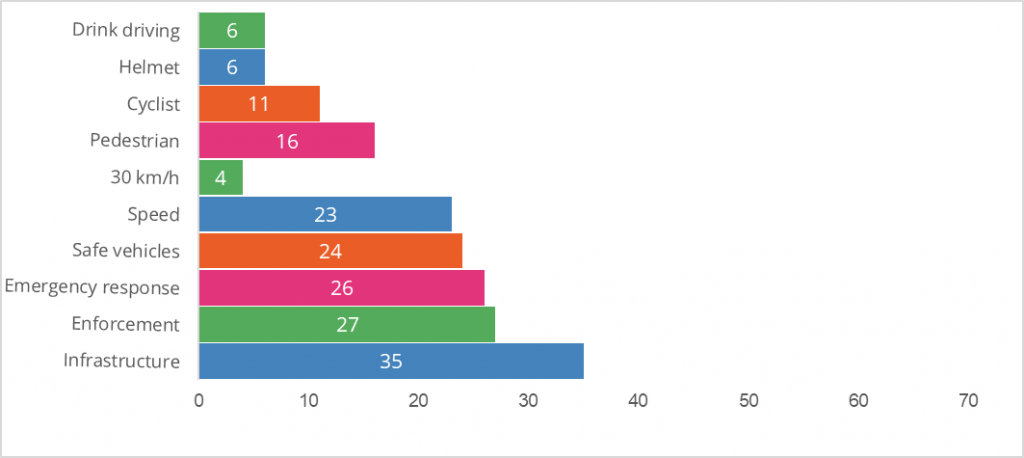
The Safe System approach opposes the claim that driver error is the primary cause of road deaths and injuries and acknowledges the inadequacies in the road system designs including vehicles and infrastructure are the primary causes and therefore highlights the need to intervene the system and not its users. However, 49% (n=36) of statements pointed to the behavior of road users. Despite the Political Declaration issued at the High-level Meeting calling for commitment to implement the Safe System approach, road safety education, which attempts to fix the road users and is not an evidence-based intervention to reduce road traffic injuries, was among the interventions widely mentioned in the statements: 51% (n=37). This number was higher than any of the evidence-based interventions noted above, which were mentioned in between 5–48% (n=4–35) of statements.
Table 4: How many statements mention Education? (N=73)

Table 5: How many statements mention user behavior? (N=73)
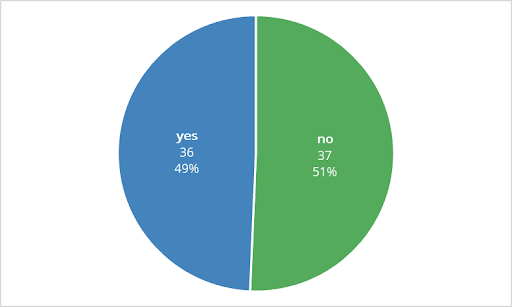
55% (n=40) of statements mentioned a specific national target to reduce road deaths and injuries. A further 30% (n=22) of statements mentioned that they were adopting the target of the Decade of Action, Global Plan, or political declaration in their country and/or other mechanisms with a target to reduce road deaths and injuries by 50% by 2030, although it cannot be definitively assumed that this means that the country itself has adopted the death and injury reduction target as a national target. These are labeled as ambiguous.
Table 6: Did the statements mention a target to reduce road traffic deaths and injuries? (N=73)
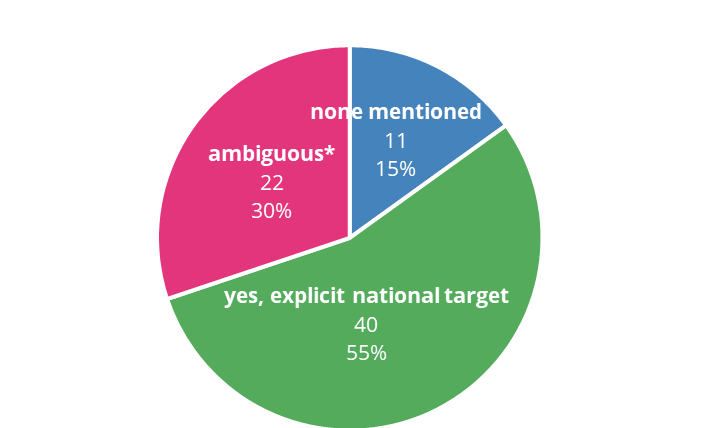
* statements that mention that they are adopting the target of the Decade of Action, Global Plan, or political declaration in their country
Of the 40 that explicitly mentioned national death or injury reduction targets, 67% (N=27) mirrored the 50% reduction by 2030 of the Decade of Action, and 33% (N=13) mentioned a different, country-specific target.
Table 7: What was the specific target mentioned? (N=40)

The details of region/countries’ targets and how they will achieve them could be expected to be found in their national strategy or action plan. 82% (n=60) mentioned that their country/region had an existing national strategy/action plan or were in the process of preparing one.
Table 8: Did the statements mention a national strategy or action plan? (N=73)
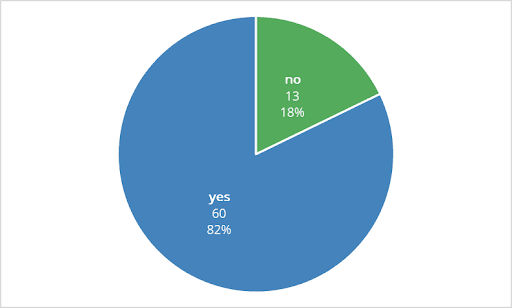
Note: that not mentioning a road safety strategy or target does not imply that a country does not have one, only that it was not mentioned in the statement. Several countries known to have a road death reduction target or national strategy did not mention them.
47% (n=34) mentioned civil society participation.
Table 9: Did the statements mention civil society participation? (N=73)
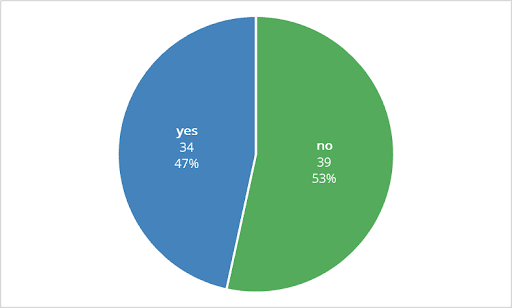
In addition to mentioning national strategies/action plans and targets (see 3 a.), investment is a strong indicator of accountability to implement meaningful road safety action.
21% (n=15) of statements mentioned government funding for either domestic or international road safety.
Table 10: Did the statements mention government investment? (N=73)

Of those who mentioned funding (N=15), 27% (n=4) mentioned a specific monetary value; 67% (n=10) mentioned domestic government spending or commitments, while 33% (n=5) mentioned foreign commitments or spending by contributing to the UN Global Road Safety Fund. Those who mentioned domestic government spending or commitments only represent 14% (10 of 73) of all the statements.
Table 11: How many statements mentioned a specific monetary value? (N=15)

Table 12: Did the statements mention domestic or international investment? (N=15)

The Alliance’s analysis compares the 73 statements made by Member States and the European Union during the Plenary session. Secretariat staff watched the plenary statements live during the High-level Meeting, using the NGO checklist to identify mentions for specific indicators, aligned to the NGO call to action and the Endorsement List to be published in fall 2022. Two staff members worked together with one taking notes and the other checking and adding additional notes. After the High-level Meeting, staff members listened to every statement again, verifying the initial inputs and adding them to a spreadsheet. Any queries or anomalies were then checked by a different staff member. The data was analyzed to produce the results.
[1] It is important to note that just because a statement does not include a particular mention (for example a national strategy) this does not mean that it does not exist for that country. However, the fact that certain intervention(s) are not mentioned in such a highly political event suggests that they are not seen as a major priority.
[2] ITF (2022), The Safe System Approach in Action, OECD Publishing, Paris.
[3] Note: this does not imply that the other 66% (n=48) of countries are not implementing a safe system approach but simply that they did not include it in their statement.